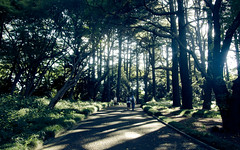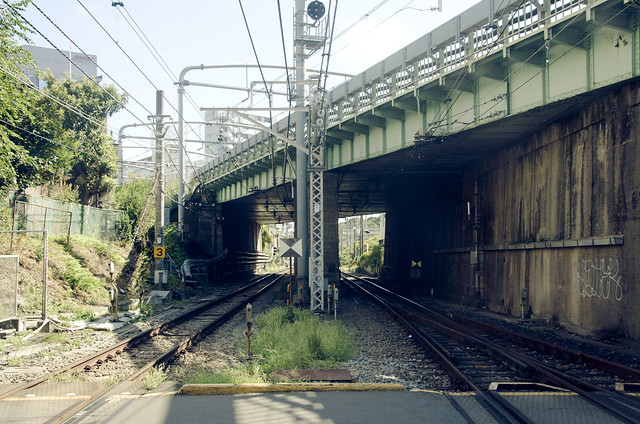1 Which continues my streak of paying to enter a botanical garden whose flowers are not in bloom.
1 for a few hours and read To Kill A Mockingbird on a park bench in the shade. I even ate an early dinner. I didn’t mean to: I was hoping to find a soba place between Gyoen and the train station but couldn’t find any and ended up at Pepper Lunch again. Everything’s like that in Japan: if you’re looking for it you can’t find it. You’ll just end up in the same place you ate at last week. Next time I’ll plan on not looking for soba.Tomorrow, my observance of Old People’s Day continues with a very traditional and respectable trip to Hakone
2 A national park/onsen resort in the shadow of Mt. Fuji.
2, a whirlwind walking tour of Kamakura—the OLD old capital—on Tuesday, and, on a whim, the Grand Sumo Tournament. I decided to run down to Ryogoku today to buy some cheap day-of tickets and lucked into some primo-seats at a… “reasonable” price. Now, if only I can find a Kabuki theater, I will have fallen into a near-perfect Tour of Old Style Japan. That’s the right way to celebrate OLD old people.The weather has turned for the better. It is still a little warm, but the humidity has pretty much blown away. It’s almost as if someone took a lid off of Japan and the steam just evaporated. Don’t get me wrong: I still feel like the sweatiest person in all of Japan, but now when I sweat, eventually I dry.
Speaking of which, I was in Shinjuku primarily to do some more tenugui shopping. My inside information suggested that there were two shops in a little strip mall called “Mosaic” between Lumine1 and Lumine 2, under a place called MyLord. Well, there was only one, and it sucked, too. All of the patterns where pretty much the same as Kamawanu, which means that even the touristy omiyage shop that my mom found in Kyoto Station had more interesting designs. The search continues. Or maybe I should just go back to Chidori. After all, in addition to their patterns being more interesting, their colors being more vibrant, and their selection bigger, they carried furoshiki ”
3 90cm x 90cm tenugui, which are normally 35x90, for package wrapping.
3. That’s what all of the ladies like anyway.I’m sure I’ll have more on Hakone, Kamakura, and the Sumo Tournament later… like when I actually go there. So maybe you’re wondering about the Sword Museum. Well, it was okay. It was a single floor of sword blades on display, mostly from the 13th and 14th centuries, mostly notable for either being “important historical artifacts” or “important artistic artifacts”
4 Though the distinction was lost on me as the explanations were all in Japanese.
4. At something like ¥$6, it’s a bit steep for a quick 20 minute walk-through, but in honor of Keiro-no-Hi, I felt like it was the least that I could do! I did come away with a stack of printed literature that I will eventually not-read and stash away in some cubby hole for the next ALT to find, wonder at and probably trick into going, but I’m not sure I’d recommend it to anyone if they asked.





Last week was our Bunkasai: I was asked to do my TSCA write up on it, but I am finding I am at a loss for words. My first two drafts came off heavy-handed and didactic. I’m not sure why I’m concerned about the literary merits of a TSCA write up… but I am at a complete loss of words to describe what it’s like. To me, Bunkasai in California was an annual event meant to (literally) celebrate Japanese Culture. Sure, there’s a tiny bit of that at Ichikashi: one room dedicated to wood carvings and calligraphy paintings (with an ikebana display shoehorned in), a tea ceremony room, and a leather-craft and pottery display/sale. And yet I think a closer analog than even an Obon festival is GVBC’s Harvest Festival.
For one time every year, the students are called to think of themselves not as Ichikashi students, but as a homeroom. They make class room t-shirts that they wear instead of their uniforms, which is a pretty big deal. As a group they decide what they want to do, be it sell food, host carnival games, build a mini-ride or haunted house—of which there were plenty—put on a puppet show or dance review, or a mini-, 1-hour musical presentation of the Lion King, complete with costumes, dance numbers and prancing gazelle puppets
5 Which makes sense since bunraku is a traditional Japanese performance art… which I need to add to my Official Keiro-no-Hi Celebration List.
5.So, even though there’s not a lot of traditional Japanese culture on display, there is a subtle undercurrent suggesting that these booths and shows are, in fact, cultural displays, telling the teachers, community outsiders, and visiting alumni a little bit about who the students are and maybe a little bit about what Japan’s future, in them, is going to look like.
Maybe.
I’d hate to think that Japan is going to be 60% haunted houses, but looking at their track record…








No comments:
Post a Comment